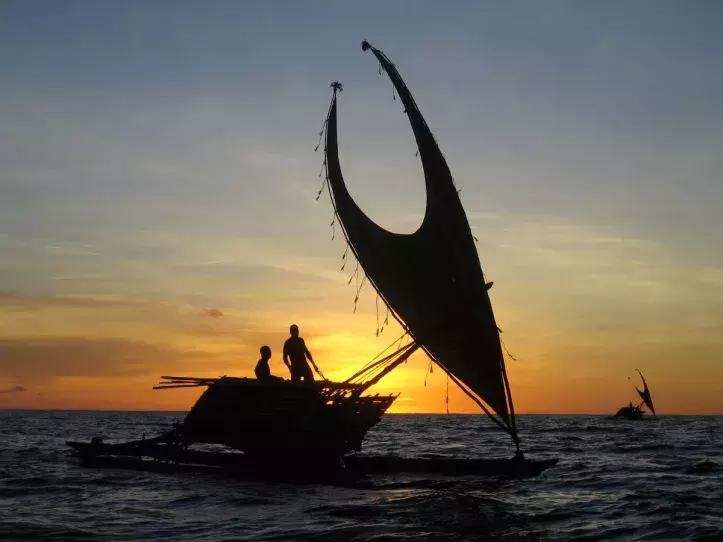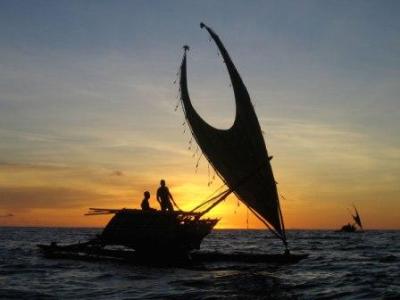Error message

OFFICE/DEPARTMENT

We the Voyagers: Lata’s Children (Matou Nga MokuPuna o Lata), a two-part documentary film series featuring the ethnically Polynesian voyagers of Taumako, Solomon Islands, who share their history, motivations, and skills through storytelling, canoe building, and wayfinding. They use only the traditional designs, materials, and methods of their cultural hero Lata, who according to legend built the first voyaging canoe (vaka) and navigated to distant islands.
Each film is an hour long, and there will be a short intermission between the two screenings. Hosted by Bishop Museum and cosponsored by the East-West Center, the evening will be led by Dr. Marianne “Mimi” George, anthropologist, sailor, and writer specializing in voyaging cultures.
Online Registration Required
Admission: $10 General, $7 Youth (Bishop Museum members receive 10% off tickets)
Schedule:
5:30 pm: Registration
6:00 pm: Part 1 Screening
7:00 pm: Short Intermission
7:15 pm: Part 2 Screening
Part 1. We, the Voyagers: Our Vaka
We, the Polynesian voyagers of Taumako, Solomon Islands, share our history, motivations, and skills through storytelling, canoe building, and wayfinding. We recall our ancestors, who made the greatest of human migrations. We use only the designs, materials, and methods of our culture-hero Lata, who built the first voyaging canoe (vaka) and navigated to distant islands. When Europeans took over, we became isolated. To regain sustainability, our most experienced navigator, Te Aliki Kaveia, led us in planting gardens, feeding workers, making rope from plants, weaving and sewing sails, protecting our trees, adzing parts for voyaging canoes, and lashing them together. Kaveia enlisted an anthropologist to help us make this film. After he died in 2009, we built a vaka. Te Aliki Holani, our new Lata, prepared us for an open-ocean voyage. From the living story of Lata we learn that everyone is welcome in Lata’s crew, and that we can avoid making key mistakes as we strive to connect with long-lost family and new friends on faraway shores.
Part 2. We, the Voyagers: Our Moana
In our isolated Polynesian community, we live the story of our ancestral culture-hero Lata. To make a voyage, Lata welcomes men, women, and children as crew, including both hard workers with skills and applicants of dubious character. Our community blesses the vessel and sailors, and we learn how to sail in Lata’s arms. We find our way in the open ocean by interacting with patterns of winds, waves, stars, and other signs that our ancestors show us when we need them. We arrive at islands and learn what happened to family members since the last voyage some generations earlier. We reconcile, reaffirm our love for each other, and look to our future together.
About Dr. Marianne “Mimi” George
Dr. Mimi George is an anthropologist, sailor, and writer who specializes in voyaging cultures. Before the her involvement in the Vaka Taumako Project, she documented voyaging traditions of islanders in New Ireland, Papua New Guinea, and Siberian Yupik Eskimos on the Alaskan and Russian sides of the Bering Strait. Her research voyages have used ancient polar technology, and the early nineteenth-century European technique of wintering-over in a sailboat frozen in the sea ice of Antarctica. In the Vaka Taumako Project, she studies and works with ethnically Polynesian Solomon Islanders who are building vessels and making voyages using ancient technology, materials, tools, and navigation methods. Mimi has made some 25 inter-island voyages in the Solomons' Santa Cruz Islands, and one voyage from there through Vanuatu, either under the sailing direction of the late master navigator Te Aliki Kaveia or with him on board.

We the Voyagers: Lata’s Children (Matou Nga MokuPuna o Lata), a two-part documentary film series featuring the ethnically Polynesian voyagers of Taumako, Solomon Islands, who share their history, motivations, and skills through storytelling, canoe building, and wayfinding. They use only the traditional designs, materials, and methods of their cultural hero Lata, who according to legend built the first voyaging canoe (vaka) and navigated to distant islands.
Each film is an hour long, and there will be a short intermission between the two screenings. Hosted by Bishop Museum and cosponsored by the East-West Center, the evening will be led by Dr. Marianne “Mimi” George, anthropologist, sailor, and writer specializing in voyaging cultures.
Online Registration Required
Admission: $10 General, $7 Youth (Bishop Museum members receive 10% off tickets)
Schedule:
5:30 pm: Registration
6:00 pm: Part 1 Screening
7:00 pm: Short Intermission
7:15 pm: Part 2 Screening
Part 1. We, the Voyagers: Our Vaka
We, the Polynesian voyagers of Taumako, Solomon Islands, share our history, motivations, and skills through storytelling, canoe building, and wayfinding. We recall our ancestors, who made the greatest of human migrations. We use only the designs, materials, and methods of our culture-hero Lata, who built the first voyaging canoe (vaka) and navigated to distant islands. When Europeans took over, we became isolated. To regain sustainability, our most experienced navigator, Te Aliki Kaveia, led us in planting gardens, feeding workers, making rope from plants, weaving and sewing sails, protecting our trees, adzing parts for voyaging canoes, and lashing them together. Kaveia enlisted an anthropologist to help us make this film. After he died in 2009, we built a vaka. Te Aliki Holani, our new Lata, prepared us for an open-ocean voyage. From the living story of Lata we learn that everyone is welcome in Lata’s crew, and that we can avoid making key mistakes as we strive to connect with long-lost family and new friends on faraway shores.
Part 2. We, the Voyagers: Our Moana
In our isolated Polynesian community, we live the story of our ancestral culture-hero Lata. To make a voyage, Lata welcomes men, women, and children as crew, including both hard workers with skills and applicants of dubious character. Our community blesses the vessel and sailors, and we learn how to sail in Lata’s arms. We find our way in the open ocean by interacting with patterns of winds, waves, stars, and other signs that our ancestors show us when we need them. We arrive at islands and learn what happened to family members since the last voyage some generations earlier. We reconcile, reaffirm our love for each other, and look to our future together.
About Dr. Marianne “Mimi” George
Dr. Mimi George is an anthropologist, sailor, and writer who specializes in voyaging cultures. Before the her involvement in the Vaka Taumako Project, she documented voyaging traditions of islanders in New Ireland, Papua New Guinea, and Siberian Yupik Eskimos on the Alaskan and Russian sides of the Bering Strait. Her research voyages have used ancient polar technology, and the early nineteenth-century European technique of wintering-over in a sailboat frozen in the sea ice of Antarctica. In the Vaka Taumako Project, she studies and works with ethnically Polynesian Solomon Islanders who are building vessels and making voyages using ancient technology, materials, tools, and navigation methods. Mimi has made some 25 inter-island voyages in the Solomons' Santa Cruz Islands, and one voyage from there through Vanuatu, either under the sailing direction of the late master navigator Te Aliki Kaveia or with him on board.






